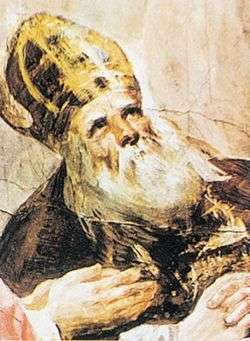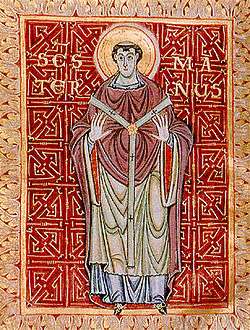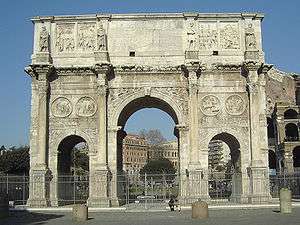315
Year 315 (CCCXV) was a common year starting on Saturday (link will display the full calendar) of the Julian calendar. At the time, it was known as the Year of the Consulship of Constantinus and Licinianus (or, less frequently, year 1068 Ab urbe condita). The denomination 315 for this year has been used since the early medieval period, when the Anno Domini calendar era became the prevalent method in Europe for naming years.
| Millennium: | 1st millennium |
|---|---|
| Centuries: | |
| Decades: | |
| Years: |
|
| 315 by topic |
|---|
| Leaders |
| Categories |
|
| Gregorian calendar | 315 CCCXV |
| Ab urbe condita | 1068 |
| Assyrian calendar | 5065 |
| Balinese saka calendar | 236–237 |
| Bengali calendar | −278 |
| Berber calendar | 1265 |
| Buddhist calendar | 859 |
| Burmese calendar | −323 |
| Byzantine calendar | 5823–5824 |
| Chinese calendar | 甲戌年 (Wood Dog) 3011 or 2951 — to — 乙亥年 (Wood Pig) 3012 or 2952 |
| Coptic calendar | 31–32 |
| Discordian calendar | 1481 |
| Ethiopian calendar | 307–308 |
| Hebrew calendar | 4075–4076 |
| Hindu calendars | |
| - Vikram Samvat | 371–372 |
| - Shaka Samvat | 236–237 |
| - Kali Yuga | 3415–3416 |
| Holocene calendar | 10315 |
| Iranian calendar | 307 BP – 306 BP |
| Islamic calendar | 316 BH – 315 BH |
| Javanese calendar | 195–196 |
| Julian calendar | 315 CCCXV |
| Korean calendar | 2648 |
| Minguo calendar | 1597 before ROC 民前1597年 |
| Nanakshahi calendar | −1153 |
| Seleucid era | 626/627 AG |
| Thai solar calendar | 857–858 |
| Tibetan calendar | 阳木狗年 (male Wood-Dog) 441 or 60 or −712 — to — 阴木猪年 (female Wood-Pig) 442 or 61 or −711 |
Events
By place
Roman Empire
- Constantine the Great and co-emperor Licinius battle the Sarmates, the Goths and the Carpians along the Danube. Constantine leads a punitive expedition into Dacia and reestablishes the Roman fortifications of the frontier.
- July 25 – The Arch of Constantine is completed near the Colosseum at Rome to commemorate Constantine's victory over Maxentius at the Milvian Bridge. As part of the ceremony Constantine is expected to make a sacrifice to Rome's traditional gods, but he refuses to do so.
- Constantine I dedicates the Basilica of Maxentius and installs a large statue of himself inside it.
- Crucifixion is abolished as punishment in the Roman Empire.
- A program of assistance to the poor is established in the Roman Empire.
- Immense baths are constructed in Augusta Treverorum (modern Trier).
By topic
Religion
- Eusebius becomes bishop of Caesarea (approximate date).
- The lamb becomes the symbol of Jesus in Christian art.
Births
- Flavius Hannibalianus, king of Armenia and Pontus (d. 337)
- Hilary of Poitiers, bishop and Doctor of the Church (d. c. 367)[1]
- Himerius, Greek sophist and rhetorician (d. 386)
- Vettius Agorius Praetextatus, Roman politician (d. 384)
Deaths

Saint Valerius of Saragossa

Saint Maternus of Cologne
- January 29 – Saint Valerius, bishop of Zaragoza (martyred)
- September 14 – Saint Maternus of Cologne (b. 285)
Date Unknown
Galeria Valeria, Empress consort of Roman Empire
Liu Cong, Empress consort of China
Prisca, Empress consort of Roman Empire
gollark: Which dendrite only half has.
gollark: No, there's a special appservice API for it.
gollark: dendrite also does not support bridges.
gollark: I mean, I don't actually know if it could be much of a security risk, but there was a thing about privilege levels not being checked properly I think?
gollark: And could theoretically be a security issue, but I don't think anyone actually did anything bad with that.
References
- "Saint Hilary of Poitiers - bishop of Poitiers". Encyclopedia Britannica. Retrieved November 7, 2017.
This article is issued from Wikipedia. The text is licensed under Creative Commons - Attribution - Sharealike. Additional terms may apply for the media files.
